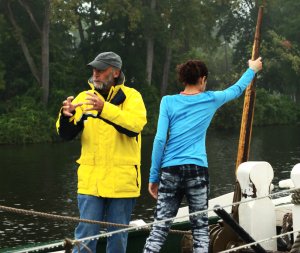by Art Cohn
September 23, 2011
We left Mechanicville and headed north to Fort Edward now confident in our ability to combine the Urger and Lois school programs. Fort Edward is one of those important junction points where the cliché about “location, location, location” is well illustrated. Its position on the upper Hudson River and to waterways leading to Lake’s Champlain and George have endowed this historic “carrying place” with a legacy of military and commercial history. Today, the river around Fort Edward is a beehive of activity as one of the largest dredging projects ever undertaken is working to restore the Hudson River’s water quality. In conjunction with that project, our LCMM Maritime Research team has spent significant time in the area and we are presently conserving several timbers from the original Fort Edward and have helped identify and document an early version of a Lake Champlain sailing canal boat.
Fort Edward was a natural crossroads on the busy waterways that provided the area their first transportation corridors. The site was well traveled by Native Peoples and a trading post/fort was the first European establishment here.

During the Colonial wars, Great Britain built the fort that gives Fort Edward its name and association with Robert Roger’s and his Rangers, the unfortunate Jane McCrea and thousands of rank and file troops provide Fort Edward a strong connection to the national story. The annual 18th Century reenactment weekend took place during the weekend of our visit at the Roger Island Visitors Center and provided a living link to those earlier times and several of our museum crew took part in that event.
During Lois McClure’s travels through the Champlain Canal, it has become my habit to always read and re-read the journals of Captain Theodore Bartley, the memoir’s of Tonawanda canal boatman Richard Garrity and the recollections of Captain Fred Godfrey’s “The Champlain Canal: Mules to Tugboats”. Having these extraordinary written accounts has helped me travel back in time and better visualize what the canal and its villages were like during the days when mules towed Lois McClure-type canal boats through the countryside. The Champlain Canal we see today is actually the third evolution of the engineered waterway from Lake Champlain to the Hudson River and Fort Edward is a wonderful place to examine previous canal episodes. Just a short walk from the current Yacht Basin and you can see the intact masonry locks from the “Enlarged” canal (1862) and the stone arches of an aqueduct that once carried Little Wood Creek over the original Champlain Canal. The Hutchinson 1830 Survey Map, courtesy of New York State Archives, shows the layout of the original canal through Fort Edward, including the aqueduct. I am pleased to report that LCMM has recently been tasked with creating an inventory of the remaining structural features of the previous canals.


But our current four-day visit to Fort Edward was not to document the canal but to share its story with all the students from Fort Edward’s 4th, 5th and 6th grades on Thursday-Friday and the public on Saturday-Sunday. Now working with our friends from the Urger, we eagerly anticipated the opportunity and it did not disappoint. The students were enthusiastic and well behaved and they circulated from station to station aboard the Lois and on the shore with the Urger crew.

The Urger drew too much water to join us at the wall, so the Canal folks made the effort to bring their exceptional working lock model to the site. Watching the student’s faces as the Urger crew demonstrated the locks workings while moving model boats from one level to another suggested that what we were doing was significant. When more than 20 of the participating students returned to the Lois over the weekend and guided their families through the boat I was convinced.
One highlight of the students visit was having the Elementary School principal come down to see the program. The principal turned out to be John Godfrey, whose family had worked the canal during the towpath and tugboat days and whose grandfather was the same Fred Godfrey who had left us such a rich written record of those times and whose book serves as one of the guides to our interpretation.
I would like to thank the Chamber of Commerce for taking the Lois and Urger crews to dinner at the wonderful Anvil Inn. I would also like to thank the citizens of Fort Edward for their hospitality, warmth and interest.
Art Cohn
